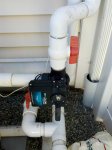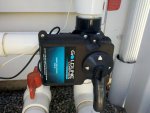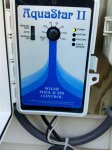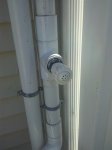That looks like a typical install for Heliocol solar panels (VRV not very high off the equipment pad). You should not have to have the panels individually drained unless one of three things is wrong on the install:
1) They are installed so that all the water could not flow out the bottom and back into the pool when the system is off. Think of it like if you opened up a panel at the top and poured some water down into it. Are the panels and pipes arranged so the water would flow out, or would the water get trapped somewhere?
2) The 3-way valve traps water. A proper install would have used a non-positive/solar valve or else the installer might have drilled a 1/8" hole in the valve diverter. I'm not sure how to verify that without taking the valve apart - are you OK with doing that?
3) The VRV is stuck. It seems at least possible that a vacuum could keep enough water up in the system to cause a problem.
But since you already opened it (the VRV), #3 really can't be an issue. And since the no water came out when you opened it, item #2 above should not be an issue. So really only item #1 would cause a problem that I can see.
Caveat: I'm in Florida and do not have to face the consequences of a wrong decision on the same scale that you would.





